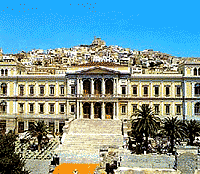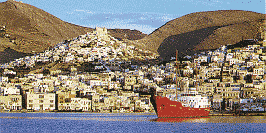The northern part of Siros is mountainous and the island stands out in general for the variety of the landscape in its hinterland, where hills alternate with low-lying farming areas.
 The coastline is indented with inlets of all sizes between capes. There are two large bays, of Ermoupoli to the east and Finikas to the west.
The coastline is indented with inlets of all sizes between capes. There are two large bays, of Ermoupoli to the east and Finikas to the west.
Archaeological excavations have shown that Siros was inhabited in Neolithic times.
Digs at Kastri and Halandriani have revealed a prehistoric acropolis, a settlement and a burial ground, and yielded artifacts of the Early Cycladic period.
Ermoupoli, “Queen of the Cyclades”, is the capital and main harbour of Siros. It is also without doubt the capital of all the Cyclades. Ermoupoli stands on a naturally amphitheatrical site, with neo-classical buildings, old mansions and white houses in the island style cascading down to the harbour. The centre of the town, where Miaouli Square stands ringed with cafes, has a grandeur all its own.
Among the most important buildings are the Town Hall (to plans by Ziller) and the Apollo Municipal Theatre, which is a copy in miniature of La Scala, Milan. There is also a statue of Admiral Miaoulis.
Ermoupoli has numerous magnificent churches, the most interesting of which are those dedicated to the Transfiguration, the Dormition of Our Lady, St Demetrius, the Three Hierarchs, and St Nicholas.
The Archaeological Museum has a collection of notable finds, and the Municipal Library contains numerous interesting and rare editions.
 The quarter of the town known as Vaporia, where the sea-captains lived, is of special interest. Along its narrow streets stand neo-classical mansions.
The quarter of the town known as Vaporia, where the sea-captains lived, is of special interest. Along its narrow streets stand neo-classical mansions.
Ano Siros (Upper Siros), with its walls, narrow lanes and arches, has kept much of its medieval character. The steep streets and countless steps lend the town the charm of a bygone age.
At the very top of the town is the Catholic Cathedral of St George, next to which stands the Centre for Historical Studies. Not far below are the monasteries of the Jesuits and Capucins. In the centre of the town is the Town Hall, with the Historical Archives of the Municipality of Ano Siros, and the Museum devoted to the popular composer Markos Vamvakaris, revered as one of the masters of Greek music. Various folklore events take place in Ano Siros, generally during the summer.
On the north-east side of the island are Halandriani and Kastri hill, where important prehistoric finds have been made.
The beaches of north-west Siros are difficult to reach. Among places of interest here is Gramata, where inscriptions dating from the Roman and Byzantine periods are to be found carved on the rocks.
The southern and western parts of Syros are the most densely-inhabited. The best beaches are also here, including Galissas, a fine, large resort with a long sandy beach; Possidonia or Delagratsia, a coastal area with a good beach at Angathopes and neo-classical houses of great architectural interest; Vari, with an attractive beach, Finikas bay, Kim and Megas Gialos.
There are more good swimming beaches at Kimata, Aghios Nikolaos, Ermoupoli, Ambela, Delfini and Ahladi.
Siros is well-supplied with tourist amenities and its natural beauties and interesting monuments make it an ideal holiday destination. The ease of availability of products and services give the island an advantage over its more isolated neighbours.
 The coastline is indented with inlets of all sizes between capes. There are two large bays, of Ermoupoli to the east and Finikas to the west.
The coastline is indented with inlets of all sizes between capes. There are two large bays, of Ermoupoli to the east and Finikas to the west.Archaeological excavations have shown that Siros was inhabited in Neolithic times.
Digs at Kastri and Halandriani have revealed a prehistoric acropolis, a settlement and a burial ground, and yielded artifacts of the Early Cycladic period.
Ermoupoli, “Queen of the Cyclades”, is the capital and main harbour of Siros. It is also without doubt the capital of all the Cyclades. Ermoupoli stands on a naturally amphitheatrical site, with neo-classical buildings, old mansions and white houses in the island style cascading down to the harbour. The centre of the town, where Miaouli Square stands ringed with cafes, has a grandeur all its own.
Among the most important buildings are the Town Hall (to plans by Ziller) and the Apollo Municipal Theatre, which is a copy in miniature of La Scala, Milan. There is also a statue of Admiral Miaoulis.
Ermoupoli has numerous magnificent churches, the most interesting of which are those dedicated to the Transfiguration, the Dormition of Our Lady, St Demetrius, the Three Hierarchs, and St Nicholas.
The Archaeological Museum has a collection of notable finds, and the Municipal Library contains numerous interesting and rare editions.
 The quarter of the town known as Vaporia, where the sea-captains lived, is of special interest. Along its narrow streets stand neo-classical mansions.
The quarter of the town known as Vaporia, where the sea-captains lived, is of special interest. Along its narrow streets stand neo-classical mansions.Ano Siros (Upper Siros), with its walls, narrow lanes and arches, has kept much of its medieval character. The steep streets and countless steps lend the town the charm of a bygone age.
At the very top of the town is the Catholic Cathedral of St George, next to which stands the Centre for Historical Studies. Not far below are the monasteries of the Jesuits and Capucins. In the centre of the town is the Town Hall, with the Historical Archives of the Municipality of Ano Siros, and the Museum devoted to the popular composer Markos Vamvakaris, revered as one of the masters of Greek music. Various folklore events take place in Ano Siros, generally during the summer.
On the north-east side of the island are Halandriani and Kastri hill, where important prehistoric finds have been made.
The beaches of north-west Siros are difficult to reach. Among places of interest here is Gramata, where inscriptions dating from the Roman and Byzantine periods are to be found carved on the rocks.
The southern and western parts of Syros are the most densely-inhabited. The best beaches are also here, including Galissas, a fine, large resort with a long sandy beach; Possidonia or Delagratsia, a coastal area with a good beach at Angathopes and neo-classical houses of great architectural interest; Vari, with an attractive beach, Finikas bay, Kim and Megas Gialos.
There are more good swimming beaches at Kimata, Aghios Nikolaos, Ermoupoli, Ambela, Delfini and Ahladi.
Siros is well-supplied with tourist amenities and its natural beauties and interesting monuments make it an ideal holiday destination. The ease of availability of products and services give the island an advantage over its more isolated neighbours.

